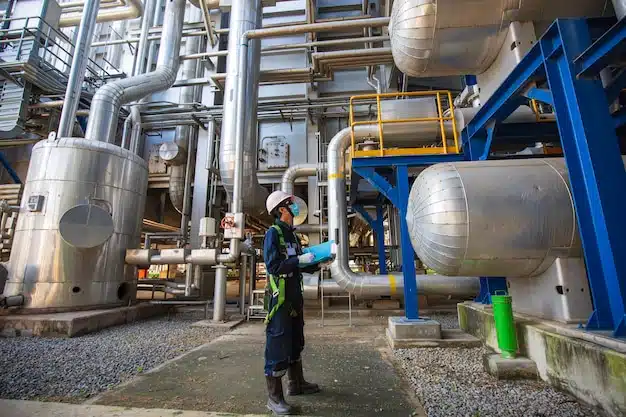
The design of Heating, Ventilation, and Air Conditioning – HVAC Design plays an important role in the oil and gas industry to ensure working conditions for both personnel and equipment. Proper HVAC design not only enhances productivity and comfort but also checks safety in hazardous environments.
Here, we will explore the key aspects of HVAC design tailored specifically for the oil and gas sector.
What is the role of HVAC Design in the Oil and Gas industry?
The role of HVAC design in the oil and gas industry is to create a safe, comfortable, and productive working environment while ensuring the efficient operation of various processes. Check some key aspects of HVAC design and its importance in the oil and gas industry:
Personnel Comfort:
Oil and gas facilities often operate in extreme environmental conditions, including high temperatures, harsh winters, and remote locations. HVAC design ensures a comfortable working environment for personnel, promoting productivity and well-being.
Equipment Protection:
Oil and gas facilities house sensitive equipment and machinery that require controlled temperature and humidity levels for optimal performance and longevity. HVAC design helps regulate these conditions, preventing equipment damage and downtime.
Hazardous Environment:
The oil and gas industry involves handling hazardous materials and potentially toxic gases. HVAC systems play a crucial role in maintaining positive pressure in control rooms and enclosed spaces, preventing the entry of harmful substances, and ensuring a safe working environment.

Indoor Air Quality:
HVAC systems help filter and purify indoor air, removing dust, pollutants, and airborne contaminants. This is especially crucial in oil and gas facilities where clean air is essential to protect the health of personnel and maintain the integrity of equipment.
Fire and Gas Detection:
Some advanced HVAC designs are equipped with fire and gas detection capabilities. In the event of a fire or gas leak, these systems can activate alarms and ventilation measures to safeguard personnel and prevent the escalation of emergencies.
Environmental Compliance:
HVAC systems can be designed to meet environmental regulations and emission standards. By properly managing air quality and ventilation, oil and gas facilities can reduce their environmental impact and meet compliance requirements.
Energy Efficiency:
HVAC designs in the oil and gas industry are engineering systems to be energy-efficient. Implementing energy-saving technologies and practices helps reduce operational costs and minimizes the facility’s carbon footprint.
There are a number of factors that need to be considered when designing an HVAC design for an oil and gas facility.
What are the key considerations for HVAC Design in Oil and Gas plants?
The oil and gas industry is a demanding environment, with extreme temperatures, hazardous materials, and potential for explosions. HVAC designs are improtant for maintaining a safe and comfortable working environment for employees, and for protecting equipment from damage.
- The climate in the area where the facility is located.
The climate will determine the type of HVAC system that is needed. For example, a facility in a hot, humid climate will need a different type of HVAC design than a facility in a cold, dry climate.
- The type of work that is done at the facility.
It will also affect the type of HVAC system that is needed. For example, a facility that uses hazardous materials will need an HVAC design that can remove those materials from the air.

- The size of the facility.
It will determine the capacity of the HVAC system. A larger facility will need a larger HVAC design than a smaller facility.
- The budget available for the HVAC Design.
The budget will determine the type of HVAC design that can be purchased. A larger budget will allow for the purchase of a more budget friendly HVAC system.
- The safety and security of the facility.
The HVAC system should be designed to protect the safety and security of the facility. For example: To prevent the spread of fire or explosions.
- The environmental impact of HVAC Design.
The HVAC system should be designed to minimize the environmental impact. For example, the HVAC design should use energy-efficient components.
What are the different types of HVAC Designs for Oil and Gas Industry?
The type of HVAC design that is best suited for a particular building will depend on the size of the building, the climate, and the budget.
Packaged units:
These units are self-contained and can be located either indoors or outdoors. They are a good option for small businesses or homes.
Centralized systems:
These systems have a central unit that distributes air to different parts of the building. They are a good option for large buildings or buildings with multiple zones.
Duct systems:
These systems do not use ducts to distribute air. Instead, they use small air handlers that are located in each room. They are a good option for homes or businesses where it is not possible to install HVAC Ducts.
Fan coil units:
These units are similar to ductless systems, but they have a fan that helps to distribute the air. They are a good option for homes or businesses where it is important to have good air circulation.
Geothermal systems:
These systems use the ground as a heat source or heat sink. They are a good option for homes or businesses that are located in areas with extreme temperatures.
In addition to these general types of HVAC designs, there are also a number of specialized HVAC designs that are used in specific applications. For example, HVAC Design for use in hospitals, data centers, and clean rooms or more in industries.
Moreover, If you are looking for a custom HVAC design for your industry? Then look no further, just contact us on info@shalindesigns.com or drop your specific needs here.